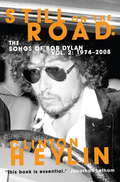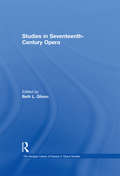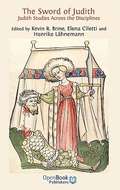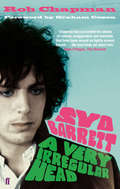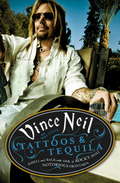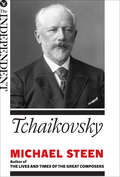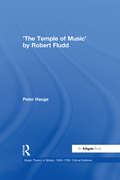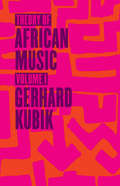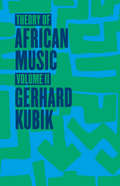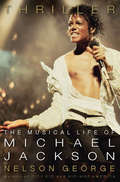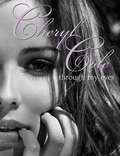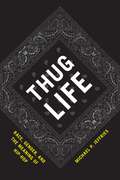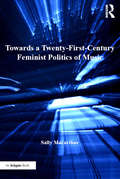- Table View
- List View
Still on the Road: The Songs of Bob Dylan Vol. 2 1974-2008
by Clinton HeylinThis is the second volume in Clinton Heylin's magisterial survey of the songs of Bob Dylan. The first volume - Revolution in the Air which is now available in paperback - charted the rise of Bob Dylan from his first jottings to the full expression of genius in songs such as 'Hard Rain Gonna Fall' and 'The Times They Are a Changin''. Still on the Road begins in 1974 with "Blood on the Tracks", the album filled with masterworks such as 'Tangled Up in Blue' and 'Simple Twist of Fate' that heralded a watershed in Dylan's creative journey, and continues to chart his never-ending fascination with music and the art of song up to 2006's "Modern Times". Praise for Revolution in the Air:'Beg, steal, borrow ... a compelling history of Dylan's mercurial song writing.' Mojo, 5-star review'Better than any biography could ever be, and a crucial Dylan book' Jonathan Letham'Valuable resource' Observer'A gripping new book by Dylan scholar Clinton Heylin so is so far in the deep end that its borderline insane . . [yet] has been devoured with a ravenous, insatiable appetite, and I have even made notes in the margin.' Mark Ellen, Word.'Terrifically interesting for Dylan nuts' Sunday Herald'Manna for completists' Metro 'True to form, Heylin digs deep-way deep-into the songs, mixing cold hard facts with illuminating anecdotes.' - Mark Smith, managing editor, Acoustic Guitar
Studies in Seventeenth-Century Opera
by BethL. GlixonThe past four decades have seen an explosion in research regarding seventeenth-century opera. In addition to investigations of extant scores and librettos, scholars have dealt with the associated areas of dance and scenery, as well as newer disciplines such as studies of patronage, gender, and semiotics. While most of the essays in the volume pertain to Italian opera, others concern opera production in France, England, Spain and the Germanic countries.
Studies in Seventeenth-Century Opera
by BethL. GlixonThe past four decades have seen an explosion in research regarding seventeenth-century opera. In addition to investigations of extant scores and librettos, scholars have dealt with the associated areas of dance and scenery, as well as newer disciplines such as studies of patronage, gender, and semiotics. While most of the essays in the volume pertain to Italian opera, others concern opera production in France, England, Spain and the Germanic countries.
The Sword of Judith: Judith Studies Across the Disciplines (PDF)
by Kevin R. Brine Elena Ciletti Henrike LähnemannThe Book of Judith tells the story of a fictitious Jewish woman beheading the general of a powerful army to free her people. The parabolic story was set as an example of how God will help the righteous. Judith's heroic action not only became a validating charter myth of Judaism itself but has also been appropriated by many Christian and secular groupings, and has been an inspiration for numerous literary texts and works of art. It continues to exercise its power over artists, authors and academics and is becoming a major field of research in its own right. The Sword of Judith is the first multidisciplinary collection of essays to discuss representations of Judith throughout the centuries. It transforms our understanding across a wide range of disciplines. The collection includes new archival source studies, the translation of unpublished manuscripts, the translation of texts unavailable in English, and Judith images and music.
Syd Barrett: A Very Irregular Head (Faber Forty-fives Ser. #1)
by Rob ChapmanSyd Barrett was the lead guitarist, vocalist, and principle songwriter in the original line up of Pink Floyd. During his brief time with the band (1966-68) he was the driving force behind the unit. After he left the band he made just two further solo albums which were both released in 1970, before withdrawing from public view to lead a quiet, and occasionally troubled life in Cambridge, the town of his birth. Rob Chapman's book is the first authoritative and exhaustively researched biography of Syd Barrett that fully celebrates his life and legacy as a musician, lyricist and artist, and which highlights the influence that he continues to have over contemporary bands and music fans alike.
Tattoos & Tequila: To Hell and Back With One Of Rock's Most Notorious Frontmen
by Vince Neil Mike SagerAn explosive biography of one of America's most notorious bands - Mötley Crüe.Mötley Crüe were formed in Los Angeles in 1981, and have since gone on to become one of America's biggest-selling and notorious heavy metal acts, with nine studio albums and over 80 million album sales. Acquiring huge success by the end of the 1980s with their mixture of heavy metal and glam rock, singer Vince Neil's 'glam' look even supposedly inspired the hit Aerosmith song 'Dude (Looks Like A Lady)'. In 1992 Neil left the band to pursue a solo career before returning in 1997. The band went into hiatus in 2000 before reuniting in 2004.In TATTOOS & TEQUILA, Vince Neil chronicles his personal experiences as singer and frontman for Mötley Crüe, and his time as a participant on reality shows. Mötley Crüe were a band who always lived up to the typical image of the 'rock and roll' lifestyle, and this is captured firsthand by Neil, who writes candidly about the band's struggles with drugs, alcohol and the law. These include incidents such as bass guitarist Nikki Sixx's near fatal heroin overdose in 1987. He also details his marriages to date, as well as movingly writing about the death of his daughter Skylar from cancer in 1995. The result is a compelling look at a band and a man who have seen many highs and lows in their career.A highly-anticipated film following the group's formidable ascent to the top of the '80s rock scene will be released in February 2018.
Tchaikovsky: The Great Composers (The Great Composers)
by Michael SteenWelcome to The Independent’s new ebook series The Great Composers, covering fourteen of the giants of Western classical music. Extracted from Michael Steen’s book The Lives and Times of the Great Composers, these concise guides, selected by The Independent’s editorial team, explore the lives of composers as diverse as Mozart and Puccini, reaching from Bach to Brahms, set against the social, historical and political forces which affected them, to give a rounded portrait of what it was like to be alive and working as a musician at that time. Unlike many of the composers in this series, Tchaikovsky showed no indication of genius as a child and he spent several years as a clerk in the Ministry of Justice before entering the St Petersburg Conservatoire. His composing career only really took off in his mid-30s. Late starter he may have been but, in the nearly twenty years left to him (he died at 53), he created some of the undisputed masterpieces of the repertoire: the operas, Eugene Onegin and The Queen of Spades, and in ballet, Swan Lake, Sleeping Beauty and The Nutcracker. The Fourth Symphony, with its fate motif, and the Sixth Symphony, the Pathétique, along with his First Piano Concerto, make constant appearances on the concert platform. Behind these achievements, as Michael Steen's gripping narrative shows, lay a life of anguish and sexual crisis as Tchaikovsky tried alternatively to accommodate and repress his homosexuality (then punishable by death in Russia). It led him to make a disastrous marriage at 37, which caused him much distress, and after only a few months, they arranged to live apart. In many ways his most successful relationship with a woman as an adult was with his patroness Nadezhda von Meck, which lasted fourteen years, during which time they never spoke to each other in person. Even today, the true cause of his death remains open to question, with competing theories jostling for acceptance.
Teaching Piano in Groups
by Christopher FisherTeaching Piano in Groups provides a one-stop compendium of information related to all aspects of group piano teaching. Motivated by an ever-growing interest in this instructional method and its widespread mandatory inclusion in piano pedagogy curricula, Christopher Fisher highlights the proven viability and success of group piano teaching, and arms front-line group piano instructors with the necessary tools for practical implementation of a system of instruction in their own teaching. Contained within are: a comprehensive history of group piano teaching; accessible overviews of the most important theories and philosophies of group psychology and instruction; suggested group piano curricular competencies; practical implementation strategies; and thorough recommendations for curricular materials, instructional technologies, and equipment. Teaching Piano in Groups also addresses specific considerations for pre-college teaching scenarios, the public school group piano classroom, and college-level group piano programs for both music major and non-music majors. Teaching Piano in Groups is accompanied by an extensive companion website, featuring a multi-format listing of resources as well as interviews with several group piano pedagogues.
'The Temple of Music' by Robert Fludd (Music Theory in Britain, 1500–1700: Critical Editions)
by Peter HaugeRobert Fludd (1574-1637) is well known among historians of science and philosophy for his intriguing work, The Metaphysical, Physical and Technical History of both Major and Minor Worlds, in which music plays an important role in his system of neoplatonic correspondences: the harmony of the universe (macrocosm) as well as the harmony of man (microcosm). 'The Temple of Music' (1617-18) is one section of this work, and deals with music theory, practice and organology. Many musicologists today have dismissed his musical ideas as conservative and outmoded or mainly based on fantasy; only the chapters on instruments have received some attention. However, reading Fludd's work on music theory and practice in the context of his own time and comparing it with other contemporary treatises, it is apparent that much of it contains highly original ideas and cannot be considered old fashioned or conservative. It is evident that Fludd's music philosophy influenced and provoked contemporary natural philosophers such as Marin Mersenne and Johannes Kepler. Less well known is the fact that Fludd's music theory reveals aspects of the development of new concepts that appear to reflect contemporary writers on music such as John Coprario and Thomas Campion. Before now, 'The Temple of Music' has not been easily accessible or available, and the fact that Fludd wrote in Latin has also been prohibitive. This critical edition provides the original Latin, an English translation and essential illustrations. The book will therefore be a useful tool for understanding the position of English music theory around 1600.
'The Temple of Music' by Robert Fludd (Music Theory in Britain, 1500–1700: Critical Editions)
by Peter HaugeRobert Fludd (1574-1637) is well known among historians of science and philosophy for his intriguing work, The Metaphysical, Physical and Technical History of both Major and Minor Worlds, in which music plays an important role in his system of neoplatonic correspondences: the harmony of the universe (macrocosm) as well as the harmony of man (microcosm). 'The Temple of Music' (1617-18) is one section of this work, and deals with music theory, practice and organology. Many musicologists today have dismissed his musical ideas as conservative and outmoded or mainly based on fantasy; only the chapters on instruments have received some attention. However, reading Fludd's work on music theory and practice in the context of his own time and comparing it with other contemporary treatises, it is apparent that much of it contains highly original ideas and cannot be considered old fashioned or conservative. It is evident that Fludd's music philosophy influenced and provoked contemporary natural philosophers such as Marin Mersenne and Johannes Kepler. Less well known is the fact that Fludd's music theory reveals aspects of the development of new concepts that appear to reflect contemporary writers on music such as John Coprario and Thomas Campion. Before now, 'The Temple of Music' has not been easily accessible or available, and the fact that Fludd wrote in Latin has also been prohibitive. This critical edition provides the original Latin, an English translation and essential illustrations. The book will therefore be a useful tool for understanding the position of English music theory around 1600.
Theory of African Music, Volume I (Chicago Studies in Ethnomusicology #1)
by Gerhard KubikTaken together, these comprehensive volumes offer an authoritative account of the music of Africa. One of the most prominent experts on the subject, Gerhard Kubik draws on his extensive travels and three decades of study in many parts of the continent to compare and contrast a wealth of musical traditions from a range of cultures. In the first volume, Kubik describes and examines xylophone playing in southern Uganda and harp music from the Central African Republic; compares multi-part singing from across the continent; and explores movement and sound in eastern Angola. And in the second volume, he turns to the cognitive study of African rhythm, Yoruba chantefables, the musical Kachamba family of Malaŵi, and African conceptions of space and time. Each volume features an extensive number of photographs and is accompanied by a compact disc of Kubik’s own recordings. Erudite and exhaustive, Theory of African Music will be an invaluable reference for years to come.
Theory of African Music, Volume I (Chicago Studies in Ethnomusicology #1)
by Gerhard KubikTaken together, these comprehensive volumes offer an authoritative account of the music of Africa. One of the most prominent experts on the subject, Gerhard Kubik draws on his extensive travels and three decades of study in many parts of the continent to compare and contrast a wealth of musical traditions from a range of cultures. In the first volume, Kubik describes and examines xylophone playing in southern Uganda and harp music from the Central African Republic; compares multi-part singing from across the continent; and explores movement and sound in eastern Angola. And in the second volume, he turns to the cognitive study of African rhythm, Yoruba chantefables, the musical Kachamba family of Malaŵi, and African conceptions of space and time. Each volume features an extensive number of photographs and is accompanied by a compact disc of Kubik’s own recordings. Erudite and exhaustive, Theory of African Music will be an invaluable reference for years to come.
Theory of African Music, Volume I (Chicago Studies in Ethnomusicology #1)
by Gerhard KubikTaken together, these comprehensive volumes offer an authoritative account of the music of Africa. One of the most prominent experts on the subject, Gerhard Kubik draws on his extensive travels and three decades of study in many parts of the continent to compare and contrast a wealth of musical traditions from a range of cultures. In the first volume, Kubik describes and examines xylophone playing in southern Uganda and harp music from the Central African Republic; compares multi-part singing from across the continent; and explores movement and sound in eastern Angola. And in the second volume, he turns to the cognitive study of African rhythm, Yoruba chantefables, the musical Kachamba family of Malaŵi, and African conceptions of space and time. Each volume features an extensive number of photographs and is accompanied by a compact disc of Kubik’s own recordings. Erudite and exhaustive, Theory of African Music will be an invaluable reference for years to come.
Theory of African Music, Volume II (Chicago Studies in Ethnomusicology #2)
by Gerhard KubikErudite and exhaustive, Gerhard Kubik’s Theory of African Music provides an authoritative account of its subject. Over the course of two volumes, Kubik, one of the most prominent experts in the field, draws on his extensive travels and three decades of study throughout Africa to compare and contrast a wealth of musical traditions from a range of cultures. In this second volume, Kubik explores a variety of topics, including Yoruba chantefables, the musical Kachamba family of Malawˆ i, and the cognitive study of African rhythm. Drawing on his remarkable ability to make cross-cultural comparisons, Kubik illuminates every facet of the African understanding of rhythm, from timing systems to elementary pulsation. His analysis of tusona ideographs in Luchazi culture leads to an exploration of African space/time concepts that synthesizes his theories of art, rhythm, and culture. Featuring a large number of photographs and accompanied by a compact disc of Kubik’s own recordings, Theory of African Music, Volume II, will be an invaluable reference for years to come.
Theory of African Music, Volume II (Chicago Studies in Ethnomusicology #2)
by Gerhard KubikErudite and exhaustive, Gerhard Kubik’s Theory of African Music provides an authoritative account of its subject. Over the course of two volumes, Kubik, one of the most prominent experts in the field, draws on his extensive travels and three decades of study throughout Africa to compare and contrast a wealth of musical traditions from a range of cultures. In this second volume, Kubik explores a variety of topics, including Yoruba chantefables, the musical Kachamba family of Malawˆ i, and the cognitive study of African rhythm. Drawing on his remarkable ability to make cross-cultural comparisons, Kubik illuminates every facet of the African understanding of rhythm, from timing systems to elementary pulsation. His analysis of tusona ideographs in Luchazi culture leads to an exploration of African space/time concepts that synthesizes his theories of art, rhythm, and culture. Featuring a large number of photographs and accompanied by a compact disc of Kubik’s own recordings, Theory of African Music, Volume II, will be an invaluable reference for years to come.
Theory of African Music, Volume II (Chicago Studies in Ethnomusicology #2)
by Gerhard KubikErudite and exhaustive, Gerhard Kubik’s Theory of African Music provides an authoritative account of its subject. Over the course of two volumes, Kubik, one of the most prominent experts in the field, draws on his extensive travels and three decades of study throughout Africa to compare and contrast a wealth of musical traditions from a range of cultures. In this second volume, Kubik explores a variety of topics, including Yoruba chantefables, the musical Kachamba family of Malawˆ i, and the cognitive study of African rhythm. Drawing on his remarkable ability to make cross-cultural comparisons, Kubik illuminates every facet of the African understanding of rhythm, from timing systems to elementary pulsation. His analysis of tusona ideographs in Luchazi culture leads to an exploration of African space/time concepts that synthesizes his theories of art, rhythm, and culture. Featuring a large number of photographs and accompanied by a compact disc of Kubik’s own recordings, Theory of African Music, Volume II, will be an invaluable reference for years to come.
Thriller: The Musical Life of Michael Jackson
by Nelson GeorgeThriller takes us back to a time in 1982 when Michael Jackson was king of the charts, breaking the color barrier on MTV, heralding the age of video, and becoming the ultimate representation of the crossover dreams of Motown's Berry Gordy, who helped launch Jackson's career with the Jackson 5. In this incisive and revealing examination of the making and meaning of Thriller, Nelson George illuminates the brilliant creative process (and work ethic) of Jackson and producer Quincy Jones, deftly exploring the larger context of the music, life, and seismic impact of Michael Jackson on three generations. All this from a groundbreaking journalist and cultural critic who was there. George questions whether the phenomenon Jackson became is even possible today. He revisits his early writings on the King of Pop and examines not only the stunning success of Thriller but also Jackson as an artist, public figure, and racial enigma-including the details surrounding his death on June 25, 2009.
Through My Eyes
by Cheryl ColeThrough My Eyes is the first official book from Cheryl Cole. Featuring a series of stunning exclusive new photos plus informal shots from her own personal collection, it gives us a unique glimpse into the life of our favourite star.From the recording studio in LA as she works on her debut album to backstage in Dublin on the opening night of her tour with the Black Eyed Peas, Cheryl shares with us some of her stand-out moments as a solo artist. We also explore the other elements of her stratospherically successful career as she takes us behind the scenes at The X Factor, into the world of L'Oreal, through the music industry's top awards ceremonies and into the windswept desert in California for a spectacular shoot under freezing conditions where we see her taking time off and enjoying rare moments of anonymity. Through the pictures that mean the most to her and their stories, which are told in her own words, Through My Eyes is a revealing and intimate portrait of the world of Cheryl Cole.
Thug Life: Race, Gender, and the Meaning of Hip-Hop
by Michael P. JeffriesHip-hop has come a long way from its origins in the Bronx in the 1970s, when rapping and DJing were just part of a lively, decidedly local scene that also venerated b-boying and graffiti. Now hip-hop is a global phenomenon and, in the United States, a massively successful corporate enterprise predominantly controlled and consumed by whites while the most prominent performers are black. How does this shift in racial dynamics affect our understanding of contemporary hip-hop, especially when the music perpetuates stereotypes of black men? Do black listeners interpret hip-hop differently from white fans? These questions have dogged hip-hop for decades, but unlike most pundits, Michael P. Jeffries finds answers by interviewing everyday people. Instead of turning to performers or media critics, Thug Life focuses on the music’s fans—young men, both black and white—and the resulting account avoids romanticism, offering an unbiased examination of how hip-hop works in people’s daily lives. As Jeffries weaves the fans’ voices together with his own sophisticated analysis, we are able to understand hip-hop as a tool listeners use to make sense of themselves and society as well as a rich, self-contained world containing politics and pleasure, virtue and vice.
Thug Life: Race, Gender, and the Meaning of Hip-Hop
by Michael P. JeffriesHip-hop has come a long way from its origins in the Bronx in the 1970s, when rapping and DJing were just part of a lively, decidedly local scene that also venerated b-boying and graffiti. Now hip-hop is a global phenomenon and, in the United States, a massively successful corporate enterprise predominantly controlled and consumed by whites while the most prominent performers are black. How does this shift in racial dynamics affect our understanding of contemporary hip-hop, especially when the music perpetuates stereotypes of black men? Do black listeners interpret hip-hop differently from white fans? These questions have dogged hip-hop for decades, but unlike most pundits, Michael P. Jeffries finds answers by interviewing everyday people. Instead of turning to performers or media critics, Thug Life focuses on the music’s fans—young men, both black and white—and the resulting account avoids romanticism, offering an unbiased examination of how hip-hop works in people’s daily lives. As Jeffries weaves the fans’ voices together with his own sophisticated analysis, we are able to understand hip-hop as a tool listeners use to make sense of themselves and society as well as a rich, self-contained world containing politics and pleasure, virtue and vice.
Thug Life: Race, Gender, and the Meaning of Hip-Hop
by Michael P. JeffriesHip-hop has come a long way from its origins in the Bronx in the 1970s, when rapping and DJing were just part of a lively, decidedly local scene that also venerated b-boying and graffiti. Now hip-hop is a global phenomenon and, in the United States, a massively successful corporate enterprise predominantly controlled and consumed by whites while the most prominent performers are black. How does this shift in racial dynamics affect our understanding of contemporary hip-hop, especially when the music perpetuates stereotypes of black men? Do black listeners interpret hip-hop differently from white fans? These questions have dogged hip-hop for decades, but unlike most pundits, Michael P. Jeffries finds answers by interviewing everyday people. Instead of turning to performers or media critics, Thug Life focuses on the music’s fans—young men, both black and white—and the resulting account avoids romanticism, offering an unbiased examination of how hip-hop works in people’s daily lives. As Jeffries weaves the fans’ voices together with his own sophisticated analysis, we are able to understand hip-hop as a tool listeners use to make sense of themselves and society as well as a rich, self-contained world containing politics and pleasure, virtue and vice.
Thug Life: Race, Gender, and the Meaning of Hip-Hop
by Michael P. JeffriesHip-hop has come a long way from its origins in the Bronx in the 1970s, when rapping and DJing were just part of a lively, decidedly local scene that also venerated b-boying and graffiti. Now hip-hop is a global phenomenon and, in the United States, a massively successful corporate enterprise predominantly controlled and consumed by whites while the most prominent performers are black. How does this shift in racial dynamics affect our understanding of contemporary hip-hop, especially when the music perpetuates stereotypes of black men? Do black listeners interpret hip-hop differently from white fans? These questions have dogged hip-hop for decades, but unlike most pundits, Michael P. Jeffries finds answers by interviewing everyday people. Instead of turning to performers or media critics, Thug Life focuses on the music’s fans—young men, both black and white—and the resulting account avoids romanticism, offering an unbiased examination of how hip-hop works in people’s daily lives. As Jeffries weaves the fans’ voices together with his own sophisticated analysis, we are able to understand hip-hop as a tool listeners use to make sense of themselves and society as well as a rich, self-contained world containing politics and pleasure, virtue and vice.
Thug Life: Race, Gender, and the Meaning of Hip-Hop
by Michael P. JeffriesHip-hop has come a long way from its origins in the Bronx in the 1970s, when rapping and DJing were just part of a lively, decidedly local scene that also venerated b-boying and graffiti. Now hip-hop is a global phenomenon and, in the United States, a massively successful corporate enterprise predominantly controlled and consumed by whites while the most prominent performers are black. How does this shift in racial dynamics affect our understanding of contemporary hip-hop, especially when the music perpetuates stereotypes of black men? Do black listeners interpret hip-hop differently from white fans? These questions have dogged hip-hop for decades, but unlike most pundits, Michael P. Jeffries finds answers by interviewing everyday people. Instead of turning to performers or media critics, Thug Life focuses on the music’s fans—young men, both black and white—and the resulting account avoids romanticism, offering an unbiased examination of how hip-hop works in people’s daily lives. As Jeffries weaves the fans’ voices together with his own sophisticated analysis, we are able to understand hip-hop as a tool listeners use to make sense of themselves and society as well as a rich, self-contained world containing politics and pleasure, virtue and vice.
Thug Life: Race, Gender, and the Meaning of Hip-Hop
by Michael P. JeffriesHip-hop has come a long way from its origins in the Bronx in the 1970s, when rapping and DJing were just part of a lively, decidedly local scene that also venerated b-boying and graffiti. Now hip-hop is a global phenomenon and, in the United States, a massively successful corporate enterprise predominantly controlled and consumed by whites while the most prominent performers are black. How does this shift in racial dynamics affect our understanding of contemporary hip-hop, especially when the music perpetuates stereotypes of black men? Do black listeners interpret hip-hop differently from white fans? These questions have dogged hip-hop for decades, but unlike most pundits, Michael P. Jeffries finds answers by interviewing everyday people. Instead of turning to performers or media critics, Thug Life focuses on the music’s fans—young men, both black and white—and the resulting account avoids romanticism, offering an unbiased examination of how hip-hop works in people’s daily lives. As Jeffries weaves the fans’ voices together with his own sophisticated analysis, we are able to understand hip-hop as a tool listeners use to make sense of themselves and society as well as a rich, self-contained world containing politics and pleasure, virtue and vice.
Towards a Twenty-First-Century Feminist Politics of Music
by Sally MacarthurTowards a Twenty-First-Century Feminist Politics of Music opens up a new way of thinking about the absence of women's music. It does not aim to find 'a solution' in a liberal feminist sense, but to discover new potentialities, new possibilities for thought and action. Sally Macarthur encourages us, with the assistance of Deleuze, and feminist-Deleuzian work, to begin the important work of imagining what else might be possible, not in order to provide answers but to open up the as yet unknown. The power of thought - or what Deleuze calls the 'virtual' - opens up new possibilities. Macarthur suggests that the future for women's 'new' music is not tied to the predictable and known but to futures beyond the already-known. Previous research concludes that women's music is virtually absent from the concert hall, and yet fails to find a way of changing this situation. Macarthur finds that the flaw in the recommendations flowing from past research is that it envisages the future from the standpoint of the present, and it relies on a set of pre-determined goals. It thus replicates the present reality, so reinforcing rather than changing the status quo. Macarthur challenges this thinking, and argues that this repetitive way of thinking is stuck in the present, unable to move forward. Macarthur situates her argument in the context of current dominant neoliberal thought and practice. She argues that women have generally not thrived in the neoliberal model of the composer, which envisages the composer as an individual, autonomous creator and entrepreneur. Successful female composers must work with this dominant, modernist aesthetic and exploit the image of the neo-romantic, entrepreneurial creator. This book sets out in contrast to develop a new conception of subjectivity that sows the seeds of a twenty-first-century feminist politics of music.
